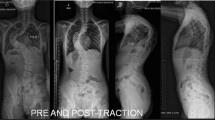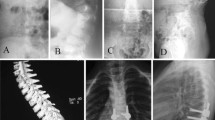Abstract
Purpose
To evaluate the clinical and radiographic outcomes of posterior vertebral column resection (PVCR) and intraoperative manual traction to correct severe post-tubercular spinal deformity incurred during childhood.
Methods
A retrospective review of 11 patients’ (4 males and 7 females) charts was performed. Clinical outcome assessment was performed using Oswestry Disability Index and Visual Analog Scale for back pain. Imaging measurements and fusion status were assessed using plain radiography and computed tomography. Intraoperative and postoperative complications were recorded.
Results
No perioperative mortality occurred among the patients. The average follow-up was 42.8 ± 13.1 months (range 25–60 months). Kyphosis improved from a preoperative average of 93.4° ± 10.1° to a postoperative average of 18.7° ± 6.3° for a correction of 80.1 %. The Cobb angle in the coronal plane improved from an average of 48.1° ± 18.9° to 10.3° ± 3.0° postoperatively for a correction of 76.3 %. At the last follow-up, two patients improved neurologically from ASIA grade C to grade D, and one patient improved from grade C to grade E. Only one patient with ASIA grade D deficits did not improve. Perioperative complications occurred in 4 of the 11 cases. One patient had a dural tear. Three patients had temporary degradation of intraoperative neuromonitoring, and one experienced transient paralysis of the left lower extremity postoperatively.
Conclusions
PVCR and intraoperative manual traction are effective alternatives to manage severe post-tubercular spinal deformity although the procedure can be highly challenging with possible neurologic complications.



Similar content being viewed by others
References
Winter RB (1976) Congenital kyphoscoliosis with paralysis following hemivertebra excision. Clin Orthop Relat Res 119:116–125
Kawahara N, Tomita K, Baba H, Kobayashi T, Fujita T, Murakami H (2001) Closing-opening wedge osteotomy to correct angular kyphotic deformity by a single posterior approach. Spine 26:391–402
Kim KT, Suk KS, Cho YJ, Hong GP, Park BJ (2002) Clinical outcome results of pedicle subtraction osteotomy in ankylosing spondylitis with kyphotic deformity. Spine 27:612–618
Reyes-Sanchez A, Rosales LM, Miramontes VP, Garin DE (2002) Treatment of thoracolumbar burst fractures by vertebral shortening. Eur Spine J 11:8–12
Rajasekaran S (2007) Buckling collapse of the spine in childhood spinal tuberculosis. Clin Orthop Relat Res 460:86–92
Rajasekaran S (2001) The natural history of post-tubercular kyphosis in children. Radiological signs which predict late increase in deformity. J Bone Joint Surg Br 83:954–962
Rajasekaran S (2012) Kyphotic deformity in spinal tuberculosis and its management. Int Orthop 36:359–365
Boachie-Adjei O, Papadopoulos EC, Pellisé F et al (2013) Late treatment of tuberculosis-associated kyphosis: literature review and experience from a SRS-GOP site. Eur Spine J 22:641–646
Hamzaoglu A, Alanay A, Ozturk C et al (2011) Posterior vertebral column resection in severe spinal deformities: a total of 102 cases. Spine 36:E340–E344
Lenke LG, Sides BA, Koester LA, Hensley M, Blanke KM (2010) Vertebral column resection for the treatment of severe spinal deformity. Clin Orthop Relat Res 468:687–699
Ditunno JF Jr, Young W, Donovan WH, Creasey G (1994) The international standards booklet for neurological and functional classification of spinal cord injury. American Spinal Injury Association. Paraplegia 32:70–80
Zhou C, Liu L, Song Y et al (2011) Anterior and posterior vertebral column resection for severe and rigid idiopathic scoliosis. Eur Spine J 20:1728–1734
Jeszenszky D, Haschtmann D, Kleinstuck FS et al (2014) Posterior vertebral column resection in early onset spinal deformities. Eur Spine J 23:198–208
Bakaloudis G, Lolli F, Silvestre MD et al (2011) Thoracic pedicle subtraction osteotomy in the treatment of severe pediatric deformities. Eur Spine J 20:S95–S104
Suk S, Kim JH, Kim WJ et al (2002) Posterior vertebral column resection for severe spinal deformities. Spine 27:2374–2382
Rajasekaran S, Vijay K, Shetty AP (2010) Single-stage closing-opening wedge osteotomy of spine to correct severe post-tubercular kyphotic deformities of the spine: a 3-year follow-up of 17 patients. Eur Spine J 19:583–592
Wang Y, Lenke LG (2011) Vertebral column decancellation for the management of sharp angular spinal deformity. Eur Spine J 20:1703–1710
Bradford DS (1987) Vertebral column resection. Orthop Trans 11:502
Yau AC, Hsu LC, O’Brien JP, Hodgson AR (1974) Tuberculosis kyphosis-correction with spinal osteotomy, halo-pelvic distraction and anterior and posterior fusion. J Bone Joint Surg Am 56:1419–1434
Suk SI, Kim JH, Kim WJ et al (1998) Treatment of fixed lumbosacral kyphosis by all posterior vertebral column resection. Presented at 5th international meeting on advanced spine techniques. Sorrento, Italy
Kawaharu H, Tomita K (2005) Influence of acute shortening on the spinal cord: an experimental study. Spine 30:613–620
Siata K, Hoshini Y, Kikkawa I, Nakamura H (2000) Posterior spinal shortening for paraplegia after vertebral collapse caused by osteoporosis. Spine 25:2832–2835
Xie JM, Zhang Y, Wang YS et al (2014) The risk factors of neurologic deficits of one-stage posterior vertebral column resection for patients with severe and rigid spinal deformities. Eur Spine J 23:149–156
Xie J, Li T, Wang Y et al (2012) Change in Cobb angle of each segment of the major curve after posterior vertebral column resection (PVCR): a preliminary discussion of correction mechanisms of PVCR. Eur Spine J 21:705–710
Huang MJ, Lenke LG (2001) Scoliosis and severe pelvic obliquity in a patient with cerebral palsy: surgical treatment utilizing halo-femoral traction. Spine 26:2168–2170
Koller H, Zenner J, Gajic V et al (2012) The impact of halo-gravity traction on curve rigidity and pulmonary function in the treatment of severe and rigid scoliosis and kyphoscoliosis: a clinical study and narrative review of the literature. Eur Spine J 21:514–529
Suk SI, Chung ER, Kim JH et al (2005) Posterior vertebral column resection for severe rigid scoliosis. Spine 30:1682–1687
Ferguson J, Hwang SW, Tataryn Z et al (2014) Neuromonitoring changes in pediatric spinal deformity surgery: a single-institution experience. J Neurosurg Pediatr 13:247–254
Acknowledgments
This work was funded in part by the National Natural Science Foundation of China (81371919).
Conflict of interest
None.
Author information
Authors and Affiliations
Corresponding author
Rights and permissions
About this article
Cite this article
Lü, G., Wang, B., Li, Y. et al. Posterior vertebral column resection and intraoperative manual traction to correct severe post-tubercular rigid spinal deformities incurred during childhood: minimum 2-year follow-up. Eur Spine J 24, 586–593 (2015). https://doi.org/10.1007/s00586-015-3760-1
Received:
Revised:
Accepted:
Published:
Issue Date:
DOI: https://doi.org/10.1007/s00586-015-3760-1




